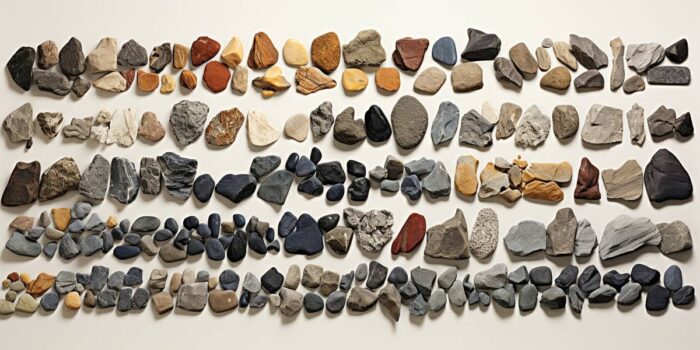Understanding the complexities of the crushed stone size chart can seem daunting to those unfamiliar with the industry’s ins and outs. Yet, it’s critical for anyone involved in construction, landscaping, or agriculture. Crushed stone is a versatile material used in various sectors, each requiring a specific size for optimal performance. From constructing solid foundations to creating decorative landscape features, the uses of crushed stone are as diverse as the stone sizes themselves.
This comprehensive guide aims to decode the crushed stone size chart, detailing each stone size’s applications and benefits. Whether you are a professional in the field or a homeowner planning a DIY project, this guide will help you better understand crushed stone sizes and their practical implementations. Let’s delve into the intriguing world of crushed stone and its multifaceted sizes.
Importance of Understanding Crushed Stone Sizes
Role in Construction Industry
Understanding the crushed stone size comparison chart is crucial in the construction industry. Crushed stones are integral to creating a concrete mix, building foundations, constructing roads, and making asphalt. Different sizes of crushed stones serve unique purposes, and the nature of the project dictates their selection.
Importance in Landscaping Projects
In landscaping projects, various crushed stone sizes are utilized to enhance outdoor spaces’ visual appeal and functionality. They may be used to create garden paths, decorate flower beds, and improve drainage. Knowledge of the crushed stone size chart aids in selecting the appropriate stone size for the required aesthetic and functional impact.
Use in Agricultural Sector
In agriculture, crushed stone is mainly used for improving soil drainage and stability. Different stone sizes are used for various purposes – for example, larger sizes for better drainage and smaller sizes for compact stability. Familiarity with the crushed stone size chart assists in making the right choice for each agricultural need.
Explanation of Crushed Stone Sizes
Fine Stone Dust
This is the smallest size of crushed stone, often referred to as stone screenings. It ranges from dust-like particles to a maximum size of 1/4 inch. Fine stone dust is commonly used to create a firm base layer.
#8 Stone
Also known as pea gravel, #8 stone measures about 3/8 to 1/2 inch in diameter. It’s a popular choice for decorative purposes and walkway installations due to its aesthetic appeal and ease of walking on.
#57 Stone
#57 stone typically falls in the range of 1/2 to 1 inch in diameter. It’s versatile in concrete mixes, driveway construction, and septic field bedding due to its excellent drainage capabilities.
#1 Stone
#1 stone spans in size from 2 to 4 inches. Its larger size makes it ideal for heavy-duty construction projects like building foundations and road construction.
#3 Stone
#3 stone is slightly smaller than #1 stone, generally ranging from 1 to 2 inches. It is commonly used for drainage in ditches and trenches and as a base for heavy structures.
Riprap Stone
This is the largest size of crushed stone, usually measuring between 3 and 8 inches in diameter. Its primary use is for erosion control, like stabilizing shorelines and slopes.
Understanding Screen Sizes and Crushed Stone Grades
Role of Screen Sizes
Screen sizes play a crucial role in producing different crushed stone sizes. After the raw stone is crushed, screens of various sizes are used to separate the crushed stone into their respective sizes.
Impact of Crushed Stone Grades
Crushed stone grades significantly affect the performance and suitability of the stones for various applications. The grade refers to the size and quality of the crushed stone, impacting its drainage capabilities, stability, and compaction characteristics.
Practical Applications of Different Crushed Stone Sizes
Uses of Fine Stone Dust
Due to its excellent compaction capabilities, fine stone dust is primarily used as a base material for paving blocks, patios, and pathways.
Applications of #8 Stone
#8 Stone is widely used in landscaping to decorate and create smooth walking paths. It’s also utilized as pipe bedding due to its drainage properties.
Purposes of #57 Stone
#57 stone is commonly used in the concrete mix, under slabs, and for drainage systems. It’s also used as a base for driveways and pavers.
Implementations of #1 Stone
#1 Stone is primarily used for building heavy-duty road bases, construction entrances, and foundation backfill.
Utilization of #3 Stone
#3 Stone is utilized in drainage applications, such as ditches and trenches, and as a base material under concrete slabs and heavy equipment.
Applications of Riprap Stone
Riprap stone is used for erosion control, such as stabilizing shorelines, riverbanks, and slopes.
Factors Influencing the Selection of Crushed Stone Sizes
Selecting the right crushed stone size is not a decision to be made lightly. It involves considering multiple factors to ensure that the chosen stone will fit the project requirements.
One of the primary considerations is the project’s purpose. The intended use of the crushed stone plays a significant role in determining its size. For instance, larger stone sizes like #1 or #3 might be the preferred choice if you’re constructing a road. Conversely, smaller sizes like #8 stone or fine stone dust might be more suitable for decorative landscaping or pathway construction.
The soil conditions on your project site also significantly impact the crushed stone size choice. If the soil is particularly soft or prone to shifting larger, heavier stones might be necessary to provide stability. On the other hand, in areas with solid, well-draining soil, smaller rocks may suffice.
Drainage requirements are another critical consideration. Larger stone sizes offer better drainage, making them ideal for projects like French drains or septic systems.
The aesthetic effect you wish to achieve can also dictate the stone size. Smaller stones offer a smoother, more uniform look, while larger stones create a more rugged, natural aesthetic.
Lastly, local regulations might influence your decision. Some jurisdictions have rules regarding the size of the crushed stone that can be used for certain projects. Always ensure you are familiar with any such regulations in your area before selecting your stone size.
In summary, understanding the influencing factors is crucial for making an informed decision about the crushed stone size for your project.
Common Misunderstandings about Crushed Stone Sizes
In the realm of crushed stone, some common misconceptions can lead to misguided decisions and less-than-optimal results.
One frequent misunderstanding is that larger stone sizes offer better quality or performance. Yet, the size of the crushed stone does not equate to its effectiveness or suitability for a project. Each stone size has unique properties and applications. For instance, larger stones provide better drainage and stability, but smaller rocks offer superior compaction and aesthetic appeal.
Another misconception is that all crushed stones are alike, disregarding the role of their source material. Different types of rocks – limestone, granite, or basalt – yield crushed stones with varying characteristics, such as color, texture, and hardness. These factors can significantly impact the stone’s functionality and appearance.
Finally, some people tend to overlook the importance of consulting the crushed stone size chart when selecting the stone. This chart comprehensively compares different sizes, helping users choose the right stone for their needs. Misunderstanding or neglecting it could lead to unsuitable choices, affecting the project’s success.
Understanding the crushed stone gravel size chart and making an informed decision can optimize the efficiency and aesthetics of construction, landscaping, and agricultural projects. Thus, the size chart for crushed stone is an invaluable tool in these industries.







